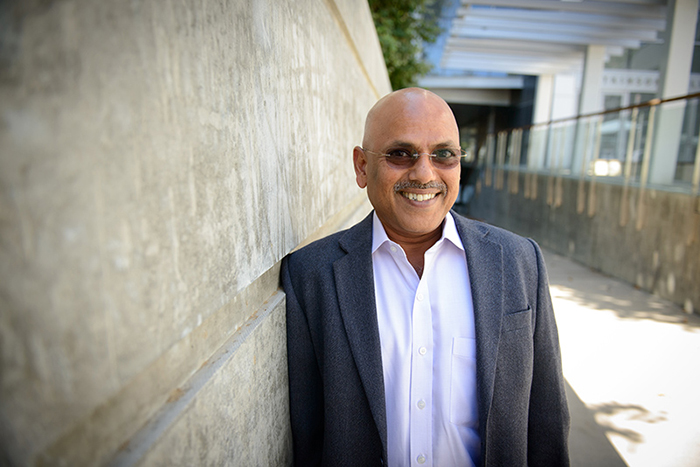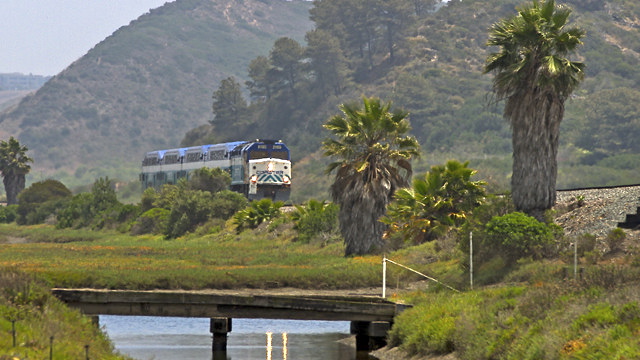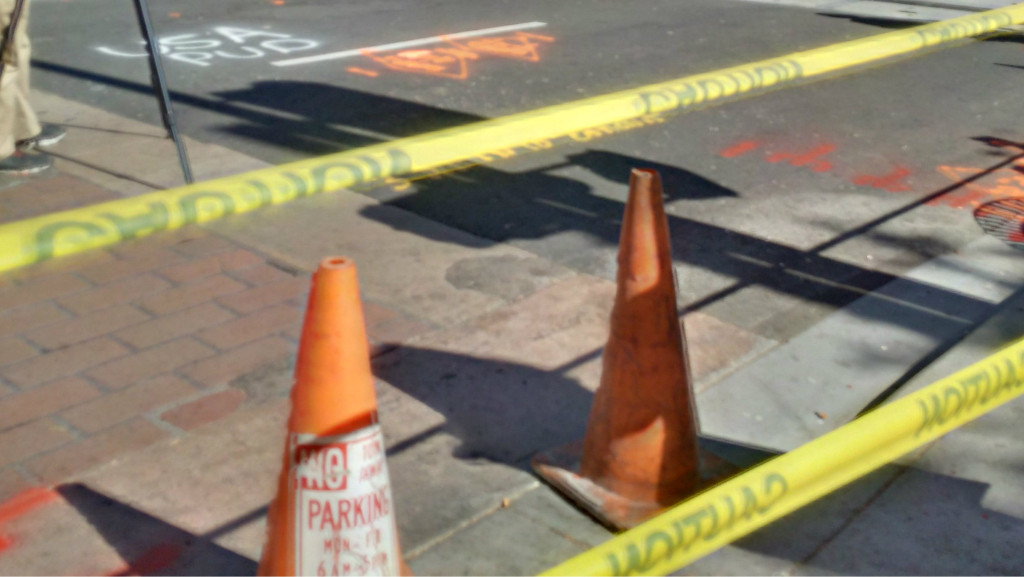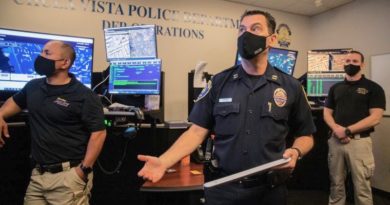Daily Business Report-Aug. 18, 2016
Road work. (Photo by Alexander Nguyen)
Poor Roads Cost Average San Diego
Motorist $1,900 a Year, Study Says
By City News Service
Poor road conditions in the San Diego area cost the average motorist about $1,900 a year due to higher vehicle costs, traffic crashes and congestion-related delays, according to a report released Wednesday by a national transportation group.
According to TRIP’s report, 67 percent of roadways in the San Diego urban area are in poor or mediocre condition, costing the average motorist an additional $722 each year in extra vehicle operating costs, including accelerated vehicle depreciation, additional repair costs and increased fuel consumption and tire wear.
In addition, traffic congestion in the area is worsening, causing 42 annual hours of delay for the average San Diego motorist and costing each driver $887 annually in lost time and wasted fuel.
Factoring in the costs of crashes in which roadway features likely were a contributing factor, the overall average cost to area motorists is $1,858 per year, said the Washington, D.C.-based organization.
TRIP’s survey found that 3 percent of bridges in the San Diego area are structurally deficient and 13 percent are functionally obsolete.
“These conditions are only going to get worse if greater funding is not made available at the state and local levels,” said Will Wilkins, TRIP’s executive director.
“Without adequate investment, California’s transportation system will become increasingly deteriorated and congested, hampering economic growth and the quality of life of the state’s residents.”
The report found that throughout the state, 37 percent of major locally and state-maintained roads are in poor condition and one quarter of California’s bridges are structurally deficient or functionally obsolete.
The state’s major urban roads are becoming increasingly congested, with drivers wasting significant amounts of time and fuel each year, and more than 14,000 people were killed in crashes on California’s roadways from 2010 to 2014, according to the report.
The annual cost for San Diegans may be high, but it’s worse in other areas, TRIP said, noting the Los Angeles-Orange County cost of $2,826 a year and the Bay Area’s $2,824 a year.
_________________________________

UC San Diego, San Diego State
Roll Out Research Platform
A team of engineers from the University of California San Diego and audiologists from San Diego State University has set out an ambitious timetable for delivering two new electronic platforms to dramatically improve and accelerate research on better hearing aids.
Led by Qualcomm Institute research scientist Harinath Garudadri as well as UC San Diego co-principal investigators Patrick Mercier and Bhaskar Rao, the UC San Diego-SDSU team has been awarded a $2.1 million grant from the National Institute on Deafness and Communication Disorders , one of the National Institutes of Health.
The grant was announced at the International Hearing Aid Research Conference, a venue for scientists and engineers who develop hearing aids and other technologies to help in the treatment of hearing impairment.
The six awards follow the funding agency’s Open Speech program solicitation.
In line with the two-year grant, Garudadri anticipates an 18-month timetable for release of the two new electronic platforms — the desktop version in early 2017, and the wearable, chip-based platform by the end of 2017. “We’ve already implemented the system in ANSI-C and it runs in real-time with less than 10 milliseconds of latency on a high-end MacBook,” said Garudadri, who worked for 16 years in signal processing at Qualcomm Inc., prior to joining UC San Diego’s Qualcomm Institute in 2014. “We plan to release the software in source code, PCB schematics, Gerber files, parts list and so on in the first quarter of 2017.”
_________________________________

Officials Approve $82 Million for
Coastal Rail Corridor Transit Funding
By City News Service
Area transit officials Wednesday welcomed news of $82 million in state funding to improve the coastal rail corridor in San Diego County.
The money is part of $390 million in cap-and-trade funds distributed by the California State Transportation Agency to 14 projects around the state. The grant for North County rail improvements will be managed by the Los Angeles-San Diego-San Luis Obispo Rail Corridor Agency, known as LOSSAN.
“The LOSSAN rail corridor is critical to the movement of people and goods from San Luis Obispo and Santa Barbara to Los Angeles and San Diego,” said CalSTA Secretary Brian Kelly. “We are pleased to support investments that will make passenger rail a more attractive travel alternative and help reduce congestion and GHG emissions on parallel highways.”
Projects include installing 2.6 miles of double tracking, new bridges and signal improvements in San Diego County; a new bridge and double tracking over the San Diego River; and upgrades to a train station at Poinsettia Lane in Carlsbad that’s used by the North County Transit District’s Coaster train.
The money will also be used to lease 31 new train cars and conduct a comprehensive study on integrating rail services along the 351-mile corridor, according to LOSSAN.
“We appreciate CalSTA’s support of this program, which will allow much- needed improvements to the second-busiest intercity passenger rail corridor in the nation,” said LOSSAN Chairman David Golonski. “This program of projects will result in more frequent and integrated passenger rail service, improved on-time performance and safety, and a better overall passenger experience.”
Some other projects funded by CalSTA were a planned extension of the Bay Area Rapid Transit system to San Jose, and an expansion of capacity at Union Station in Los Angeles.
_________________________________
NASA Launches Online Portal
For Space Research Findings
ExecutiveGov
NASA has unveiled a new web portal that offers public access to scientific information from various agency-funded studies.
The space agency said Tuesday it aims to expand the dissemination of fundamental space research data through the Funded Research Results portal on the NASA.gov website.
“Through open access and innovation we invite the global community to join us in exploring Earth, air and space,” noted Dava Newman, NASA deputy administrator.
“Making our research data easier to access will greatly magnify the impact of our research,” said Ellen Stofan, NASA chief scientist.
NASA created the portal to comply with the Office of Science and Technology Policy‘s directive requiring science-funding agencies to increase access to the findings of federally-funded studies.
The agency requires agency-funded researchers to make their original science journal articles publicly accessible via a publication repository called PubSpace.
_________________________________
Qualcomm Program Brings
STEM to San Diego Girls
Times of San Diego
Programming to create robo-crafts. Learning the complexities of light. And, learning the building blocks of computer vision. No, these aren’t college-level courses — they are some of the lessons at QCamp, a camp hosted by San Diego-based Qualcomm geared toward young, female students.
QCamp began in September 2013 with the goal of building a pipeline of girls and women in the science, technology, engineering and math (STEM) fields. The program launched with 30 pre-sixth grade girls from the San Diego Unified School District, who have now all participated in the program for three consecutive years.
Saura Naderi, a staff government affairs analyst and engineering instructor for Qualcomm, said QCamp stands apart from other STEM-focused programs because of its different components. The company has worked with more than 8,000 children.
“We offer hands-on exposure so anyone who goes through this experience knows what it’s like to be an engineer,” Naderi said. “But the kids also learn about the ecosystem of Qualcomm, and all the different jobs in the company that help Qualcomm succeed.”
But the best part, at least for Naderi, is seeing how confident the girls are when working in the STEM fields. It’s a welcome development considering women remain underrepresented in the science and engineering workforce. According to the National Girls Collaborative Project, women only represent 29 percent of the workforce in the U.S.
“Their confidence in STEM is just through the roof,” Naderi said. “They don’t think it’s a daunting career path. They think any career path is available to them. One girl said she doesn’t feel any barriers after going through this experience. That’s the point (of QCamp) to empower anyone to pursue the career they choose.”
The success of QCamp in the U.S. is prompting the company to offer it overseas. Qualcomm recently held its first camp in China in collaboration with the Children and Youth Science Center.
The camp worked with 40 girls between the ages of 12 and 15 from five different provinces in China.
“The goal is to provide this opportunity to underrepresented kids who may not have access to higher education,” Naderi said.
For more information about QCamp, go to Qualcomm.com.




